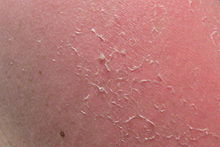- Desquamation
-
Desquamation
Peeling skin.ICD-10 R23.4 Desquamation (from Latin desquamare, meaning "to scrape the scales off a fish"), also called skin peeling, is the shedding of the outermost membrane or layer of a tissue, such as the skin.
Contents
Skin
Normal, nonpathologic desquamation of the skin occurs when keratinocytes, after moving apically over about 14 days, are individually shed unnoticeably.[1]:279 In pathologic desquamation, such as that seen in X-linked ichthyosis, the stratum corneum becomes thicker (hyperkeratosis), imparting a "dry" or scaly appearance to the skin, and instead of detaching as single cells, corneocytes are shed in clusters, forming visible scales.[1]:279 Desquamation of the epidermis may result from disease or injury of the skin. For example, once the rash of measles fades, there is desquamation. Skin peeling typically follows healing of a first degree burn or sunburn. Toxic shock syndrome, a potentially fatal immune system reaction to a bacterial infection, causes severe desquamation; so can mercury poisoning. Other serious skin diseases involving extreme desquamation include Stevens-Johnson syndrome and toxic epidermal necrolysis (TEN).[2] Radiation can cause dry or moist desquamation.[3]
How and why skin peels
The reason that skin peels is because it is dead skin. When skin cells die, they either come off in tiny particles or in large pieces. The dead skin peels because a new layer of skin is growing and pushing up. Therefore, the dead skin is pushed up and cracks, causing peeling. Skin also peels after a sunburn. The UV rays kill skin cells and cause itching or peeling of the affected skin.
Eyes
Eye tissues including the conjunctiva and cornea may undergo pathological desquamation in diseases such as dry eye syndrome.[4] The anatomy of the human eye makes desquamation of the lens impossible.[5]
See also
- Pityriasis — flaking of the skin
- Sunburn
- Moist desquamation
- For technical terms, when desquamation refers to a process affecting materials (metals, concrete, rocks, etc.), see also:
- Spall, or spalling
- Spallation
References
- ^ a b Jackson SM, Williams ML, Feingold KR, Elias PM (March 1993). "Pathobiology of the stratum corneum". West. J. Med. 158 (3): 279–85. PMC 1311754. PMID 8460510. http://www.pubmedcentral.nih.gov/articlerender.fcgi?tool=pmcentrez&artid=1311754.
- ^ Parillo, Steven J; Parillo, Catherine V. (2010-05-25). "Stevens-Johnson Syndrome". eMedicine. Medcape. http://emedicine.medscape.com/article/756523-overview. Retrieved 2010-09-06.
- ^ Centers for Disease Control and Prevention (2005-06-30). "Cutaneous Radiation Injury". CDC. http://emergency.cdc.gov/radiation/criphysicianfactsheet.asp. Retrieved 2011-05-15.
- ^ Gilbard, Jeffrey P., M.D. accessdate= 2010-09-06 (2003). "Dry Eye: Natural History, Diagnosis and Treatment". Wolters Kluwer Pharma Solutions. http://www.ophmanagement.com/article.aspx?article=85952.
- ^ Lynnerup N, Kjeldsen H, Heegaard S, Jacobsen C, Heinemeier J (2008). Gazit, Ehud. ed. "Radiocarbon Dating of the Human Eye Lens Crystallines Reveal Proteins without Carbon Turnover throughout Life". PLoS ONE 3 (1): e1529. doi:10.1371/journal.pone.0001529. PMC 2211393. PMID 18231610. http://www.plosone.org/article/info:doi/10.1371/journal.pone.0001529. Retrieved 2010-09-06.
Symptoms and signs: skin and subcutaneous tissue (R20–R23, 782) Disturbances of skin sensation/
somatosensory disorderCirculation Edema Other 
This anatomy article is a stub. You can help Wikipedia by expanding it.

